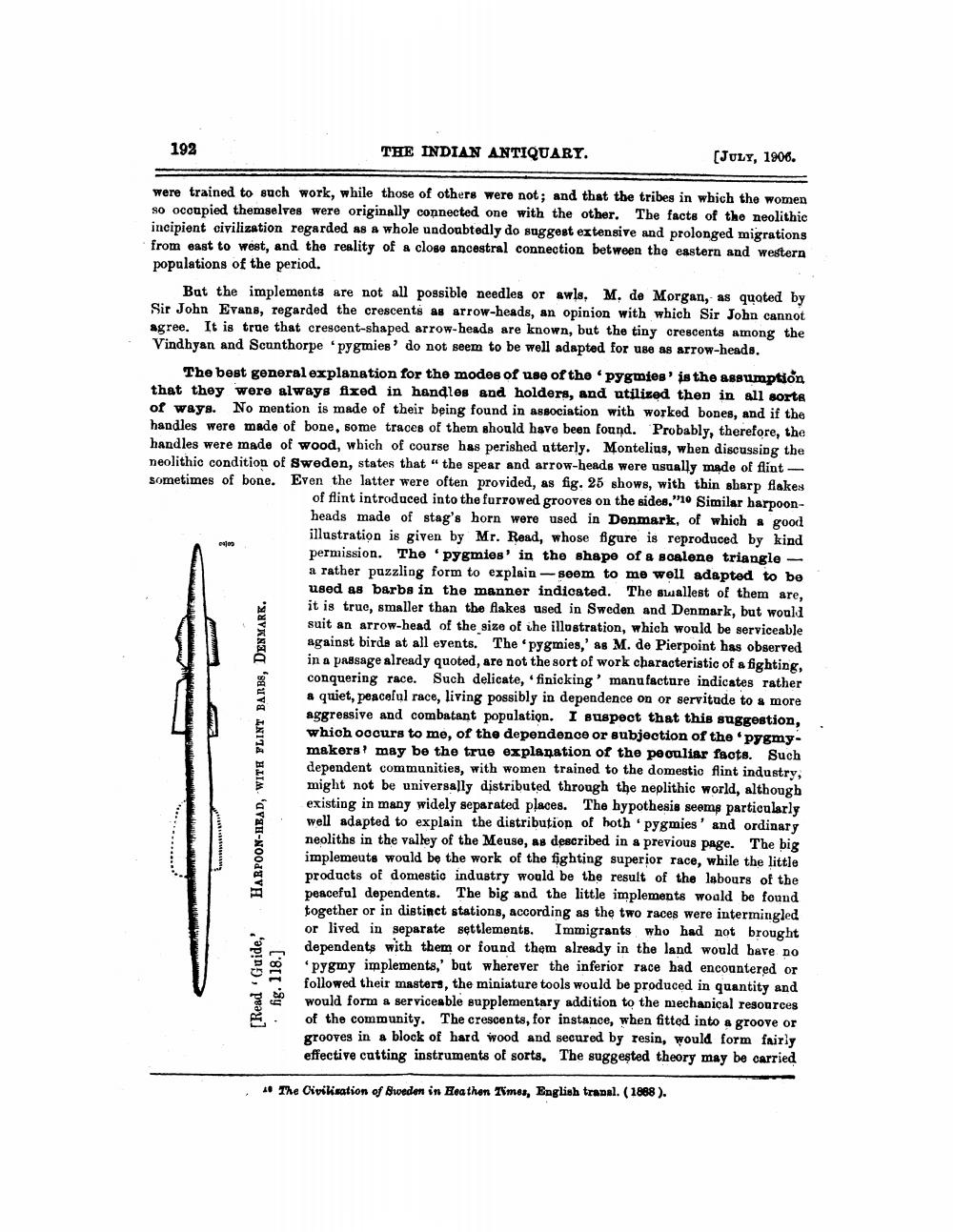________________
192
THE INDIAN ANTIQUARY.
(JULY, 1906.
were trained to such work, while those of others were not; and that the tribes in which the women so occupied themselves were originally connected one with the other. The facts of the neolithic incipient civilization regarded as a whole undoubtedly do suggest extensive and prolonged migrations from east to west, and the reality of a close ancestral connection between the eastern and western populations of the period.
Bat the implements are not all possible needles or awls, M. de Morgan, as quoted by Sir John Evans, regarded the crescents as arrow-heads, an opinion with which Sir John cannot agree. It is true that crescent-shaped arrow-heads are known, but the tiny crescents among the Vindhyan and Scunthorpe 'pygmies' do not seem to be well adapted for use as arrow-heads.
The best general explanation for the modes of use of the pygmjes' is the assumption that they were always fixed in handles and holders, and utilized then in all sorta of ways. No mention is made of their being found in association with worked bones, and if the handles were made of bone, some traces of them should have been found. Probably, therefore, the handles were made of wood, which of course has perished utterly. Montelius, when discussing the neolithic condition of Sweden, states that "the spear and arrow-heads were usually made of flint - sometimes of bone. Even the latter were often provided, as fig. 25 shows, with thin sharp flakes
of flint introduced into the furrowed grooves on the sides."10 Similar harpoonheads made of stag's horn were used in Denmark, of which a good illustration is given by Mr. Read, whose figure is reproduced by kind permission. The pygmies' in the shape of a scalene triangle - a rather puzzling form to explain - seem to me well adapted to be used as barbs in the manner indicated. The swallest of them are, it is true, smaller than the fakes used in Sweden and Denmark, but would suit an arrow-head of the size of ihe illustration, which would be serviceable against birds at all events. The pygmies,' as M. de Pierpoint has observed in a passage already quoted, are not the sort of work characteristic of a fighting, conquering race. Such delicate, 'finicking manufacture indicates rather & quiet, peaceful race, living possibly in dependence on or servitude to a more aggressive and combatant population. I suspect that this suggestion, which occurs to me, of the dependence or subjection of the pygmy. makers' may be the true explanation of the poouliar facts. Such dependent communities, with women trained to the domestic flint industry, might not be universally distributed through the neplithic world, although existing in many widely separated places. The hypothesis seems particularly well adapted to explain the distribution of hoth pygmies' and ordinary neoliths in the valley of the Meuse, as described in a previous page. The big implemeuts would be the work of the fighting superior race, while the little products of domestic industry would be the result of the labours of the peaceful dependents. The big and the little implements woald be found together or in distinct stations, according as the two races were intermingled or lived in separate settlements. Immigrants who had not brought dependents with them or found them already in the land would have no
pygmy implements, but wherever the inferior race bad encountered or followed their masters, the miniature tools would be produced in quantity and would form a serviceable supplementary addition to the mechanical resources of the community. The crescents, for instance, when fitted into a groove or grooves in a block of hard wood and secured by resin, would form fairly effective cutting instruments of sorts. The suggested theory may be carried
HARPOON-ABAD, WITH FLINT BARBS, DENMARK.
[Read Guide, . fig. 118.]
* The Civilisation of Sweden in Heathon Times, English trapal. (1888).




